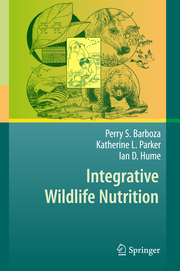Detailansicht
Integrative Wildlife Nutrition
ISBN/EAN: 9783540878841
Umbreit-Nr.: 1306824
Sprache:
Englisch
Umfang: xviii, 342 S.
Format in cm:
Einband:
gebundenes Buch
Erschienen am 28.01.2009
Auflage: 1/2009
- Zusatztext
- Nutrition spans a wide range of mechanisms from acquisition of food to digestion, absorption and retention of energy substrates, water and other nutrients. Nutritional principles have been applied to improving individual health, athletic performance and longevity of humans and of their companion animals, and to maximizing agricultural efficiency by manipulating reproduction or growth of tissues such as muscle, hair or milk in livestock. Comparative nutrition borrows from these tra- tional approaches by applying similar techniques to studies of ecology and physiology of wildlife. Comparative approaches to nutrition integrate several levels of organization because the acquisition and flow of energy and nutrients connect individuals to populations, populations to communities, and communities to ecosystems. Integrative Wildlife Nutrition connects behavioral, morphological and biochemical traits of animals to the life history of species and thus the dynamics of populations. An integrated approach to nutrition provides a practical framework for understanding the interactions between food resources and wildlife popu- tions and for managing the harvest of abundant species and the conservation of threatened populations. This book is for students and professionals in animal physiology and ecology, conservation biology and wildlife management. It is based on our lectures, dem- strations and practical classes taught in the USA, Canada and Australia over the last three decades. Instructors can use Integrative Wildlife Nutrition as a text in wildlife and conservation biology programs, and as a reference source for related courses in wildlife ecology.
- Kurztext
- Elucidates the importance of wildlife nutrition from molecules and cells to ecosystemsKey concepts are illustrated with flow diagrams of biochemical pathways and with practical examples for monitoring the nutritional status of wild animalsIncludes supplementary material: sn.pub/extras
- Autorenportrait
- InhaltsangabeContents 1 Introduction: common themes across diverse taxa 1.1 Resource supply and organismal demand 1.2 Principal components of animals and plants 1.3 Scaling body size and demands for energy and nutrients 1.4 Dietary requirements and nutritional niche 1.5 Summary: introduction Part I Functional Relationships 2 Food and populations 2.1 Population growth and animal density 2.2 Individual demands and food limits 2.3 Trophic relationships 2.4 Environmental variation 2.5 Summary: populations 3 Feeding dynamics: functional and behavioral responses 3.1 Functional response and diet breadth 3.2 Predicting foraging behavior with models 3.2.1 Optimal foraging time 3.2.2 Risksensitive foraging 3.3 Mechanics of foragingU 3.4 Form and function of the mouth 3.5 Mechanisms of foods 3.5.1 Physical characteristics of foods 3.5.2 Chemical characteristics of foods 3.6 Summary: feeding dynamics 4 Measuring food consumption 4.1 UAdjustment and steady state 4.2 Direct measures of intake 4.2.1 Behavioral observations of food intake 4.2.2 Food intake by mass balance 4.2.3 Digestible and metabolizable food intake 4.3 Indirect measures of intake 4.3.1 Measuring intake with indigestible markers 4.3.2 Measuring intake with digestible markers 4.4 Summary: food consumption 5 Digestive function 5.1 Food intake, digestive efficiency and digestive tract capacity 5.2 Reaction rates and retention time 5.3 Common functions of digestive systems 5.4 Digesta flow 5.4.1 Digesta flow in the foregut of ruminants and kangaroos 5.4.2 Digesta flow in the hindgut of herbivores 5.5 Optimizing digestive systems 5.6 Summary: digestive function Part II Substrates and Tissue Constituents 6 Carbohydrates: sugars, fiber and fermentationU 6.1 Complementary substrates for metabolism 6.2 Functions of carbohydrates 6.3 Functional chemistry of carbohydrates 6.4 Digestion and absorption of non-structural carbohydrates 6.5 Glucose metabolism and homeostasis 6.6 Digestion of structural carbohydrates 6.7 Microbial fermentation 6.7.1 Hostmicrobe relationshipsU 6.8 Summary: carbohydrates 7 Lipids: fatty acids and adipose tissue 7.1 Functional chemistry of fatty acids 7.2 Classes of lipids 7.3 Digestion and transport of lipids 7.4 Fat synthesis and mobilization 7.5 Summary: lipids 8 Nitrogenous substrates: nucleic acids to amino excretion 8.1 Amino acids and essentiality 8.2 Proteins and digestion 8.3 Intermediary metabolism of amino acids 8.4 Nucleic acids and digestion 8.5 Nitrogen metabolism 8.5.1 Ammonia 8.5.2 Urea 8.5.3 Uric acid 8.5.4 Creatinine 8.6 Nitrogen balance and the requirement for N 8.6.1 Endogenous urinary N 8.6.2 Fecal N losses 8.6.3 Protein quality 8.7 Summary: nitrogen 9 Metabolic constituents: water, minerals and vitamins 9.1 Water and electrolytes 9.1.1 Transport mechanisms 9.1.2 Aquatic exchanges of water 9.1.3 Terrestrial exchanges of water 9.1.4 Water turnover and balance 9.2 Minerals 9.2.1 Sodium, chlorine, and potassium 9.2.2 Calcium and phosphorus 9.2.3 Magnesium and sulfurU 9.2.4 Trace metals 9.2.5 Iodine and selenium 9.3 Vitamins 9.3.1 Watersoluble vitamins 9.3.1.1 B vitamins 9.3.1.2 Vitamin C 9.3.2 Fatsoluble vitamins
